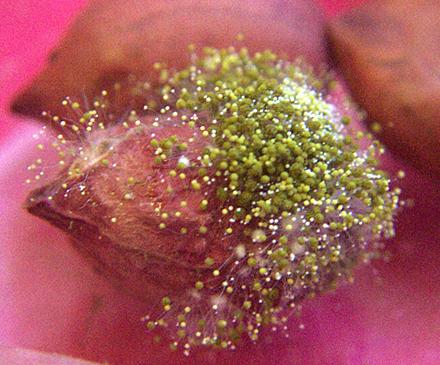Researchers Aim to Stack the Deck Against Peanut Pathogens

Aspergillus flavus, a carcinogenic aflatoxin, colonizes a peanut. (Photo courtesy of Baozhu Guo)
Genome Mapping May Speed up Process of Fighting Diseases
Diseases caused by biotic stresses – including fungus, bacteria, and viruses – are among the top killers of peanut crops, accounting for as much as 50-80% of crop losses worldwide. Adding increasing drought and possible resistance to chemical pesticide use only makes things look worse for growers in the future.
Fortunately, a team of researchers from USDA’s Agricultural Research Service (ARS) is working on ways to speed up the development of disease-resistant plants and reduce the amount of chemical pesticides sprayed into the environment.
“Abiotic stresses, like drought and climate change, take a heavy toll on peanuts in the southern United States, reducing yield and quality with potential contamination of carcinogenic aflatoxins,” said Baozhu Guo, plant pathologist at the ARS Crop Genetics and Breeding Research unit in Tifton, GA.
Carcinogenic aflatoxins are produced by fungi and are associated with an increased risk of liver cancer, according to the National Cancer Center.
“Drought stress is the single greatest contributing factor to the exacerbation of aflatoxin contamination in the field before harvest and in post-harvest environments, like storage and transportation,” Guo said. “Control strategies for biotic stresses, like fungal diseases, have historically depended on frequent chemical pesticide applications.”
The goal of his research, he said, is to develop genetic resources and breeding tools for breeding superior peanut cultivars with multiple-stress resistance. To do that, Guo and his colleagues are using information from the peanut’s genome, which was sequenced in 2016, to develop a genetic map that segregates disease resistance and susceptibility to certain pathogens.
Armed with that data, the team identifies genes or DNA markers associated with disease resistance or susceptibility.
“Simply put, we are investigating which locations on the genome provide resistance, and if these resistance regions can stack together for more resistance and high yield through breeding by using the DNA markers,” he said.
Guo’s team spins magic to speed the selection process. MAGIC, or multi-parent advanced generation inter-crosses, is what its name might suggest: a breeding method that increases genetic variations by using multiple peanuts as parents, unlike traditional crosses that come from just two parents.
“We can use this method to stack/pyramid the beneficial traits in different lines by using DNA markers and intercross breeding,” Guo said. “With traditional breeding, it is very difficult to stack more than one or two genes or traits. By doing this, we can speed up breeding by 5 to 10 years.”
In addition to breeding peanut plants to be more disease resistant, the project aims to create two peanuts with specific traits: nuts with lower fat content to make them healthier, and nuts with more fat to supply more peanut oil.
According to Guo, the project not only generates a wealth of knowledge for researchers and breeders, but it also directly impacts farmers, the peanut industry, and consumers by reducing the cost of peanuts and protecting the environment while at the same time providing quality products.
“We have a responsibility to provide food and fiber to the increasing population and to protect the environment by reducing chemical use and protecting clean water,” he said. “The cost of chemical control is high and environmentally unfriendly. Therefore, we will address these issues by improving natural peanut genetic resistance – in other words, by improving the peanut’s own immune system.” By Scott Elliott, ARS Office of Communications
Also in the series on fighting fungal pathogens:

